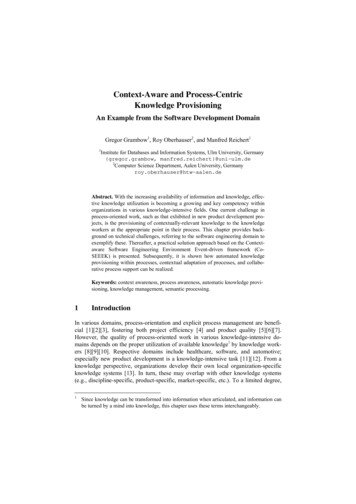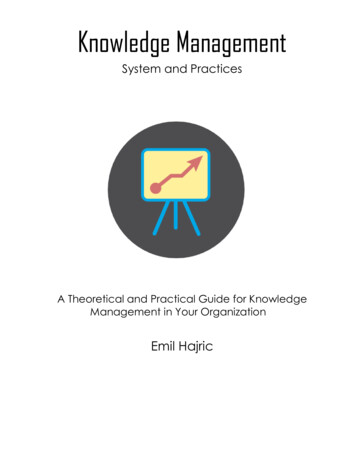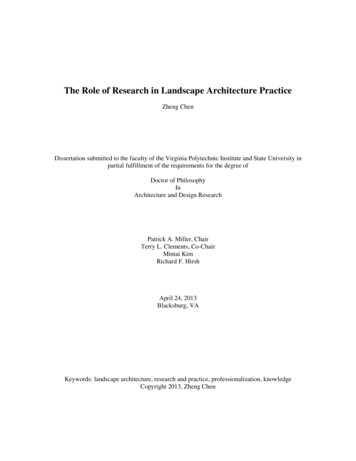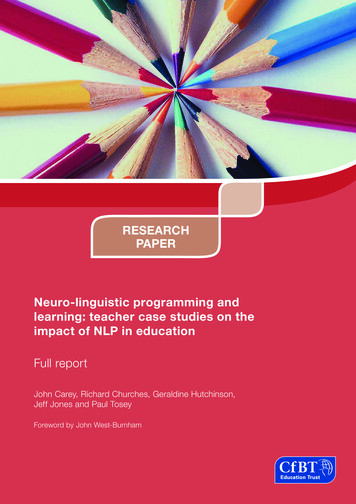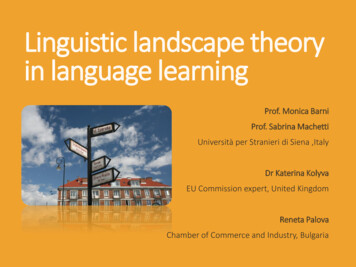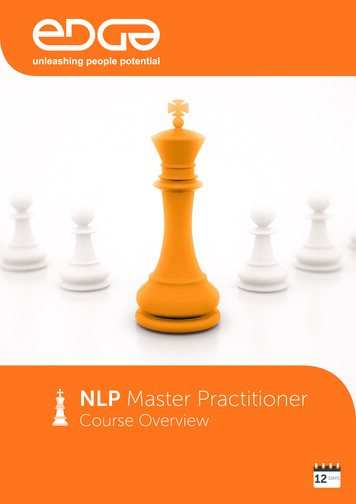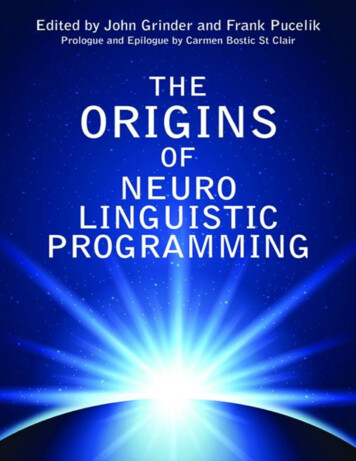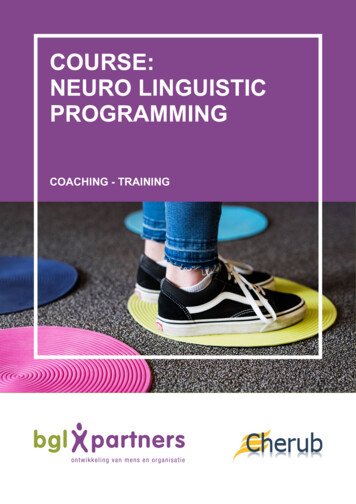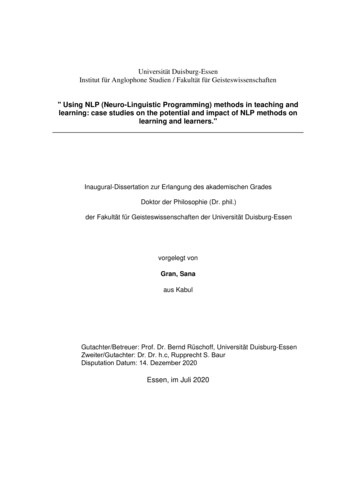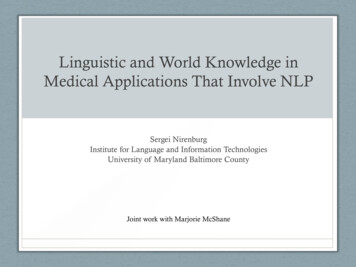
Transcription
Linguistic and World Knowledge inMedical Applications That Involve NLPSergei NirenburgInstitute for Language and Information TechnologiesUniversity of Maryland Baltimore CountyJoint work with Marjorie McShane
An ApologyThis brief presentation directly mentions only a verysmall subset of biomedical NLP systems and systemmodules.There is no implication that this choice is definitive orcomprehensive.
Linguistics-Based Medical NLP SystemsA large number of NLP systems and functionalities have been developedfor the domain of medicine.While the application systems differ on a variety of specific parameters,the core NLP functionalities of most biomedical NLP systems areidentical to those that support NLP applications outside the biomedicaldomain.
Linguistics-Based Medical NLP SystemsMost recent application systems – both general-purpose andbiomedical – are hybrid: whenever practicable, they use any kind ofavailable algorithms (statistical or otherwise) and knowledge resources(lexicons, ontologies, various rule sets, etc.) and fill in the lacunae withnewly developed capabilities.All such systems and methods are ultimately linguistics-based.
All NLP is Linguistics-BasedIndeed, statistics-based processing needs linguistic knowledge too,at the very least for: selection of features and their value sets:“In the context of language, doing “feature engineering”is otherwise known as doing linguistics”(Manning 2004); preparation of sophisticated training and test data sets (“annotatedcorpora”) to support a variety of NLP-related decisions
Approaches To Knowledge AcquisitionIn statistics-based systems the preferred method of knowledge acquisitionis learning it automatically from large text collections. As this is currentlyinfeasible, learning is instead carried out over text corpora that aremanually annotated using feature-value sets generated by humans.The approach to knowledge acquisition used in “rule-based” systems is touse human labor not for facilitating learning algorithms but for acquiringstatic knowledge and processing rules directly.
Prominent Technologies andApplication AreasMuch work in biomedical NLP is devoted to informationextraction (IE) – generating structured knowledge about an objector event of interest by detecting in open text references to valuesof elements of predefined knowledge structures.While IE can be an end application itself, it can also be viewed asan enabling technology for other end applications, such astraining (tutoring) or clinical decision support (CDS).
Three Representative IE-Based systems:The Briefest of IllustrationsTypical input and outputs of IE-oriented medical NLP applications arewell illustrated by the following example from the MedLEEenvironment.Given the input below:MedLEE generates the following output:From http://www.cat.columbia.edu/pdfs/MedLEE 2006.pdf
MedLEE generates the following output:
The MedLEE Family(e.g., Friedman 2001, Lussier et al, 2010)At origin, MedLEE has used and extended the The Linguistic String Project(LSP) system (e.g., Sager et al. 1994).Systems in the MedLEE family (MedLEE, BioMedLEE, PhenoGO) includethe following major components: standard preprocessing stages; syntactic analysis using a sublanguage grammar; a target information structure with feature-value sets specific toparticular biomedical domains and applications and encoded in a varietyof coding schemata; and domain- and application-oriented rule sets and static knowledgeresources (e.g., lexicons) for detecting relevant words and phrases in freetext documents and mapping them into appropriate values of the targetfeatures.
MetaMap(e.g., Aronson and Lang, 2010)MetaMap maps words and phrases in biomedical texts to words andphrases serving as concepts in the UMLS Metathesaurus, a structuredbiomedical knowledge resource.This mapping enhances a variety of practical applications, such asautomatic indexing of MEDLINE citations and concept-based queryexpansion.Input analysis steps in MetaMap include a battery of preprocessingmodules (from tokenization to lexical lookup), shallow syntactic parsingand lexical variant generation. Mapping steps include finding a set ofMetathesaurus string matching at least some of strings in the processedinput and finding a longest match. An optional step includes collocationbased word sense disambiguation.
SemRep(e.g., Rindfleisch and Fiszman, 2003)Stated purpose is similar to MetaMap’s: “SemRep is a naturallanguage processing system designed to recover semantic propositionsfrom biomedical text using underspecified syntactic analysis andstructured domain knowledge from the UMLS.”SemRep uses MetaMap to augment referring expressions in inputswith Metathesaurus concepts. SemRep enhances the knowledge andprocessor inventory that supports the text-to-Metathesaurus mapping.For example, special rule sets have been developed for syntax-tosemantics linking and an entire module, SemSpec, for interpretinghyperonymic propositions.
Targeting Specific FeaturesTo improve the utility of IE results, a number of biomedical NLP systemsseek to extract values of a set of features that promise to enhance thequality of the original content extraction.To give just a few examples, the ConText system (e.g., Chapman et al.2007) targets negation, a subset of time-related properties (“temporality”)and selective case role assignment (“experiencer”). The MediClass system(e.g., Hazelhurst et al. 2005) also targets negation and additionallyaddresses indicators of severity of medical events and quantification.Event extraction is a popular objective, as witnessed, for example, by thepopularity of the BioNLP Shared Task efforts in 2009 and 2011.The ultimate goal of all the above efforts is to improve results ofextraction by determining selected (“contextual”) aspects of text meaningbeyond collocation-oriented word sense disambiguation.
Focus on Training SystemsMany diverse medical training systems have been developed over the past40 years, including technical task trainers and cognitive skill trainersbased on virtual patients (VPs) that use human actors or computersimulations.Typical state-of-the-art cognitive skill training systems extract specificknowledge elements from user input to help the selection of a path througha decision tree whose nodes correspond to decision points in the trainingtask. In other words, a) training system can be viewed as a kind of decisionsupport systems; and b) NLP in these systems is typically carried out in theIE manner.For example, systems developed by MedCases, Inc., Therasim, Inc., theSim-Patient system from RTI International and systems configured in theCIRCSIM-Tutor project (e.g., Evens and Michael 2006) and in the eVIPproject (e.g., Zary 2007) fall into this broad category.
NLP in state-of-the-art virtual patient-based training systemsA user questionis keyword-matched witha prefabricated “canonical” questionand a canned answer is displayedDouglas Chesher. Exploring the use of a web-based virtual patient to support learningthrough reflection. University of Sydney PhD Thesis. 2004
Focus on Decision Support SystemsDetails about research in this area can be found in several recentsurveys of the state of the art in medical decision support systems,including:Wang et al 2007Demner-Fushman et al. 2009Berner 2009Decision support challenges are also discussed in the influentialreport from the National Research Council on computationaltechnology for health care (Stead and Lin 2009).The above materials provide excellent analyses of the issuesinvolved and cover a very large percentage of systems and projectsunder development. Just a few general comments will suffice here.
Decision Support SystemsDecision support systems can be useful in both clinical practice and inresearch environments. Clinical decision support systems may have agreater societal impact but face issues of user acceptance.Human-computer interaction in medical decision support systems can takedifferent forms, though many systems involve NLP.NLP capabilities required for HCI are not exactly the same as thoseneeded to support IE.Advanced decision support systems have separate decision-makingmodules that rely on NLP modules for decision-making knowledgeand communicating with the user.NLP capabilities required by decision-making modules are not exactly thesame as those needed to support either IE or HCI.
Decision Support SystemsSome NLP-inclusive medical decision support systems seek to extract fromtext and use not slot fillers of predefined structures but representations ofall the propositional and pragmatic/discourse meanings of a text.Chester (Allen et al. 2006), an application of the TRIPS dialog system tothe medical domain, is one such system.Maryland Virtual Patient (MVP) and Clinician’s Advisor (CLAD) are twoproof-of-concept systems developed in the OntoAgent project (e.g.,McShane et al., forthcoming; Nirenburg et al. 2010).
Chester: TRIPS for the Medical Domain(e.g., Allen et al. 2006)Chester reminds patients about medication scheduling to helpwith compliance.
OntoAgent(e.g., McShane et al, forthcoming)
MVPMVP models a team of artificial intelligent agents –notably, a virtual patient and a tutor – and a humanagent in a training system where the human plays therole of trainee.The artificial intelligent agents are implemented asdifferent instances of the OntoAgent architecture.
NLP in MVPWhen the trainee types “What brings you here?” the VP generates ameaning representation for this text (shown in a simplified ME-PATIENT-1OFFICE-23(Numbers indicate specificinstances of correspondingontological concepts)
User AcceptanceThe ultimate criterion of success of any applicationsystem is end user acceptance.A brief survey of users’ opinions about current andfuture medical decision support systems will help toidentify user desiderata for the capabilities in suchsystems, including NLP capabilities.
What Users Say1/5 Extant clinical decision support systems are failing tooffer “tailored, clinically appropriate choices” for a givenpatient. (Wright et al. 2009) Clinical QA system users want direct answers toquestions, specific recommendations, a rationale forrecommendations, a practical tempering of originalresearch with practical considerations, and an“emphasis on treatment and bottom-line advice.”(Ely et al. 2005)
What Users Want 2/5 Customizability should be stressed: different features,different rule sets, etc. (Berner et al. 2009) Systems are needed that are not monolithic – that canbe reconfigured, that can learn over time.“ Any IT-based infrastructure to support today’shealth care needs must be designed to accommodatechanges in roles and process tomorrow” (Stead andLin, 2009)
What Users Want 3/5 “Five Rights” of clinical decision support systemsmust be supported: give the right information to theright person in the right format through the rightchannel at the right time (Osheroff et al. 2009). Don’t get in the user’s way! “Alert fatigue” has leftmost decision support systems unused by clinicians.Need more work on tiered alerts, user configurationof preferences, and less overall noise from systems.(Berner 2009).
What Users Want 4/5 ““[IT applications] are often designed in ways that provide little support for the cognitive tasks ofclinicians or the workflow of the people who mustactually use the system.” “Cognitive support is not well served by the taskspecific automation systems that make up themajority of today’s health care IT.” (Stead and Lin,2009)
What Users Want 5/5Must address user’s biases: clinicians tend not to want help! Sintchenko et al. (2004) report that use of decision support inventilator-associated pneumonia treatment improved cliniciandecision-making (from 65% agreement with an expert panel to 97%)but (a) this did not affect clinician confidence in the decision(clinicians were very confident anyway) and (b) in about 2/3 of casesclinicians did not seek decision support.“Priorities in NLP development will be determined by thereadiness of intended users to adopt NLP.” (DemnerFushman et al, 2009)
What Do Users Want Clinical DecisionSupport Systems to Be Like?It seems that the users want clinical decision supportsystems that resemble HAL from Stanley Kubrick’s2001: A Space Odyssey.To jog your memory, here are a few illustrations ofsome of HAL’s capabilities:
A sample dialog with HALDave:HAL:Dave:HAL:Dave:HAL:Open the pod bay doors, HAL.I am sorry, Dave. I am afraid Ican’t do that.What’s the problem?I think you know what theproblem is just as well as I do.I don’t know what you’retalking about.I know that you and Frankwere planning to disconnectme, andI’m afraid that’s something Icannot allow to happen.HAL’s capabilities demonstratedby the dialog:Understanding of “request action”Nominal compoundingReference resolution (select examples)Politeness (emotional intelligence)Idiomaticity, politenessBelief ascription: Modeling theknowledge, actions, goals, plans of andbeliefs of othersSelf-awareness: Modeling oneself,including goals, plans, etc.Embedded modalities
HALI can tell from the tone ofyour voice, Dave, thatyou're upset.Why don't you take a stresspill and get some rest.[Dave has just drawn anothersketch of Dr. Hunter].HALCan you hold it a bit closer?[Dave does so]HALThat’s Dr. Hunter, isn’t it?DaveYes.Emotion recognition via speechPoliteness via vocativeModeling feelings of othersIndirect speech actBroad vocabulary, incl. jargonSubject ellipsis in VP-coord. structureConfident use of ambiguous lexemeReference resolved to physical objectRelative spatial orientationEllipsis of to me (closer to me)Image recognitionReference resolution to memoryGeneration of tag question.Understanding of elliptical ‘yes’.
Why aren’t we closer to a HAL yet?“As we near the year 2001, do we have a computer that sounds like thevoice of HAL portrayed by actor Douglas Rain ? The answer is no, notyet The greatest obstacle is the machine’s inability to comprehendwhat it is saying or hearing.”Joseph P. Olive (in Stork (1997), Hal’s Legacy. MIT Press p. 124.)“ [T]o understand language as well as he does, HAL would need acomplete model of the world that includes understanding his own goals,the goals of those around him and the relative significance of each. Inaddition, he would have to understand all the ways of referring to suchgoals and the potential problems that could interfere with carrying themout.”Roger Schank, ibid. p.179.
What Now?Though significant R&D progress has been made, theabovementioned obstacles are still very much present in 2012.If we want to address the task of overcoming these obstacles headon:Is the currently prevalent IE-oriented approach (whether realizedthrough statistical, rule-based or hybrid methods) scientifically themost promising?Or was the choice motivated by extra-scientific considerations?
The “Grand Research Challenge”The recent National Research Council report (Stead and Lin 2009)states:“Patient-centered cognitive support emerged as an overarching grandresearch challenge during the committee’s discussions.”“Clinicians have a “virtual patient” in mind—a conceptual model of the patientreflecting their understanding of interacting physiological, psychological,societal, and other dimensions. They use new findings—raw data—to refinetheir understanding of their virtual patient. Then, based on medical knowledge,medical logic, and mostly heuristic decision making, they formulate a plan,expressed as an order (transaction), to try to change the (real) patient for thebetter.”
How Much Effort Will It Take?We are facing a “grand challenge” project. Let’s try tocompare the size of this project with two well-known“grand challenge” projects.
The Manhattan ProjectManhattan Project expenditures in 1942-45 amounted to: 69,681,000 in 1945 dollars which corresponds to 888,014,664 in 2012 dollars.The R&D component accounted for only 3.7% of the above.Source: ST/MANHATTN.HTM
The Human Genome ProjectThe Human Genome Project expenditures in 1988 - 2003amounted to: 3,812,600,000 in 2003 dollars, which corresponds to 4,753,151,843 in 2012 dollars.The above does not include funding of genomics research outside ofthis project.Source: omics/entry.htm )
An Attempt at ComparisonAs regards the project to build a machine that can meaningfullycommunicate with people is, in my opinion, is at of at least the samecomplexity as the tasks before Manhattan and Human Genomeprojects. (I actually think that our project is much more complex thaneither of the others.) This means that the costs of these projects willbe at least commensurate.The Manhattan and Human Genome projects address societal needs(national security and health respectively) that are more immediatethan the need for our project Watson is probably the largest ever NLP project (have the numbersbeen made public?). It is a spectacular project but it does not bridgethe gap
ReferencesAronson, A.R. and F. Lang. 2010. An overview of MetaMap: historical and recent advances. JAMIA 2010, 17: 229-236.Berner, Eta S. 2009. Clinical Decision Support Systems: State of the Art. Prepared for: Agency for Healthcare Research and Quality U.S.Department of Health and Human Services, AHRQ Publication No. 09-0069-EF June 2009Coden, Anni, Guergana Savova, Igor Sominsky, Michael Tanenblatt, James Masanz, Karin Schuler, James Cooper, Wei Guan, Piet C. de Groen.2009. Automatically extracting cancer disease characteristics from pathology reports into a Disease Knowledge Representation Model, Journal ofBiomedical Informatics 42 (2009) 937–949.Manning, C. 2004. Beyond the Thunderdome. In Proceedings of CONLL-04.ELY, John W., JEROME A. OSHEROFF, M. LEE CHAMBLISS, MARK H. EBELL, MARCY E. ROSENBAUM. 2005. AnsweringPhysicians’ Clinical Questions: Obstacles and Potential Solutions, Journal of the American Medical Informatics Association Volume 12 Number 2Mar / Apr 2005, pp. 217-224.HAZLEHURST, Brian, H. ROBERT FROST, DEAN F. SITTIG, VICTOR J. STEVENS. 2005. MediClass: A System for Detecting andClassifying Encounter-based Clinical Events in Any Electronic Medical Record. Journal of the American Medical Informatics Association. Vol 12#5.Hunt DL, Haynes RB, Hanna SE, Smith K. Effects of computer-based clinical decision support systems on physician performance and patientoutcomes: a systematic review. JAMA. 1998;280:1339-46.Osheroff, J.A. 2009. Improving medication use and outcomes with clinical decision support: a step-by-step guide. Chicago, IL: The HealthcareInformation and Management Systems Society.PERSSON, M., T. MJORNDAL, B. CARLBERG , J. BOHLIN & L. H. LINDHOLM. 2000. Evaluation of a computer-based decision supporttreatment of hypertension with drugs: retrospective, nonintervention testing of cost and guideline adherence Journal of Internal Medicine 247: 8793.SINTCHENKO, VITALI, ENRICO COIERA, JONATHAN R. IREDELL, GWENDOLYN L. GILBERT. 2004. Comparative Impact of Guidelines, ClinicalData, and Decision Support on Prescribing Decisions: An Interactive Web Experiment with Simulated Cases. Journal of the American Medical InformaticsAssociation 11(1): 71-77.Stead, William W. and Herbert S. Lin, Eds. Computational Technology for Effective Health Care: Immediate Steps and Strategic Directions. TheNational Academies Press, Washington, DC.M. PERSSON, T. M JOÈRNDAL, B. CARLBERG , J. BOHLIN & L. H. LINDHOLM. 2000. Evaluation of a computer-based decision support treatment ofhypertension with drugs: retrospective, nonintervention testing of cost and guideline adherence Journal of Internal Medicine 247: 87-93.
Coden et al. 2009: Automatically extracting cancer disease characteristics from pathologyreports into a Disease Knowledge Representation ModelFriedman, C. 2000 A broad-coverage natural language processing system.Proceedings of the AMIA symposiumNirenburg, Sergei, Marjorie McShane, Stephen Beale, Jesse English and RobertaCatizone. 2010. Four kinds of learning in one agent-oriented environment. In:Samsonovich AV, Jóhannsdóttir KR, Chella A, Goertzel B., editors, Proceedings ofthe First International Conference on Biologically Inspired CognitiveArchitectures, Arlington, VA, Nov. 13-14, 2010. Amsterdam, Netherlands: IOSPress, 2010. p. 92-97.Marjorie Mcshane, Stephen Beale, Sergei Nirenburg, Bruce Jarrell, George Fantry.Forthcoming. Inconsistency as diagnostic tool in a society of intelligent agents.Artificial Intelligence in Medicine.
Reserve Slides
Dialog Excerpt from Maryland VirtualPatient (MVP)
“Under the Hood” of MVP
Decision Support in MVP: the Tutor Agent
NLP in MVPWhen the trainee types “What brings you here?” the VP first generates a“literal” meaning representation for this text (shown in a simplified 1(Numbers indicate specificinstances of correspondingontological concepts)The VP must be able to recognize and use the situational context toDESTINATIONOFFICE-23conclude that the intended meaning of the input YSET-4MEMBER-TYPESYMPTOM-1SET-4PATIENT-1Note that this conclusion maybe wrong in a particular case.SYMPTOM-1EXPERIENCERDetermination of intendedmeaning facilitates appropriatedecisions about how to respondto this request.PATIENT-1
Zooming Out from ClinicalDecision Support(From Stead and Lin) Of the committee’s 7 desiderata reflecting the IOM’svision for 21st century health care, 4 arguably require knowledge-rich systems: “Comprehensive data on patients’ conditions, treatments, and outcomes” [oneassumes it has to be collated and interpretable to be useful] “Cognitive support for health care professionals and patients to help integratepatient-specific data where possible and account for any uncertainties thatremain Cognitive support for health care professionals to help integrate evidencebased practice guidelines and research results into daily practice Empowerment of patients and their families in effective management ofhealth care decisions and their implementation, including personal healthrecords, education about the individual’s conditions and options, and supportof timely and focused communication with professional health careproviders.” [i.e., systems can’t be made for only trained specialists]
To expand later!We need knowledge-based systems to support high-endapplications, such as clinical decision support systems.To support communication with knowledge-basedsystems – and for knowledge acquisition – languageprocessing is the best way to go, in part because thedevelopment of NLP systems shares manyrequirements with the development of knowledgebased systems, e.g., decision support systems.
To expand later 2!What we need instead is to motivate the analysis of prerequisitesand desiderata for creating high-end clinical decision supportsystems by how we propose to address the current obstacles toacceptance of such systems.Note that some of the prerequisites for clinical decision supportare themselves NLP applications that are pursued quite separatelyfrom the need to support clinical decision.For example, automatic extraction of knowledge from medicalrecords.
The Specialist Lexicon .2012/jsp/getResults.jsp; accessed Apr. 19, 2012
Verbal Senses of hurt in OntoSem (in presentation format)
Deployment-Related ConcernsThe ultimate goal for any application system is broad deployment. Toattain this goal, one must take into account several often conflictingconsiderations, such as:- utility (how important is a particular application for attaining theoverall task – having a top-quality spell checker is good but having atop-quality semantic analyzer has a higher overall utility)- breadth and depth of coverage (not only of lexis and grammar but alsoof features required to support medical decision making)- nature of output (e.g., whether it is intended for direct use by people orby reasoning systems or artificial intelligent agents)- level of automation (is human help needed to produce final results?)- output quality (of both fully automatic and human-aided configurationswhere system results are validated and post-edited by people)- operational costs (these will be high for human-aided systems)- development costs.
MVPThe current implementation of MVP trains medical personnel indiagnosing and treating diseases of the esophagus.The virtual patient (VP) agent in the MVP system is “seeded” with acertain medical condition. The VP’s disease progression is simulatedover time. When the VP perceives symptoms, it initiates a visit to theMD, whose role is played by the trainee in MVP. The trainee engagesthe VP in an information-gathering dialog, orders (simulated) labwork,establishes a diagnosis and suggests a treatment. The VP may ask theMD a variety of clarification questions about conditions, tests andtreatments and influence the choice of treatments (even refuse atreatment). Treatment
cognitive skill training systems. extract specific knowledge elements from user input to help the selection of a path through a. decision tree. whose nodes correspond to decision points in the training task. In other words, a) training system can be viewed as a kind of decision support systems; and b)
